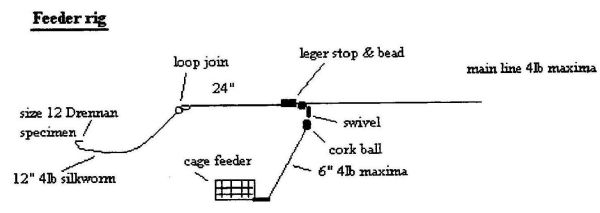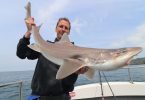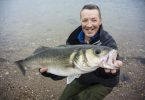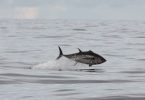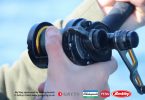I’d like to stress that I know next to nothing about mullet and the following is simply an account of my first few trips. Despite being best known as a coarse angler I am in fact I’m an all-rounder, although perch are my speciality and my favourite fish. So why fish for mullet?
Well the main reason was that in those days I ran a rod-building firm and I wanted to field test a new rod I’d developed. This rod, the “Fledgerlite”, I’d designed with perch in mind. As many of you will know, perch have a very thin membrane behind their lips, which hooks can easily pull out of. On the other hand I may need to cast a 2oz bomb, a sunken float on a long paternoster link and a sprat-sized bait right against a snag. Thus a long rod with a soft tip coupled with stiffness in the butt and the ability to handle lines up to at least 7lb. b.s. were the unusual requirements. The rod had already coped with perch to 3-12, but mullet I thought would make an ideal but sterner test.
Mulleting Experience
I had thought I’d caught a couple of mullet from a south coast pier as a lad, but on checking my father told me they were mackerel! I told you I knew nothing about mullet! A chance encounter with a member of the NMC at Mudeford at the entrance to Christchurch Harbour really started the ball rolling. This led to a couple of hours trotting bread just below the quay there last autumn but to no avail. However, it did whet my appetite, and during the heat wave in early May I tried my luck at Folkestone Harbour, which is only 20 minutes drive from home.
Folkestone Harbour
The first trip started badly. When I arrived I found there was no water in the harbour – it dries out at low tide! Nor did it improve. The owner of one of the local fishing tackle shops told me that the mullet were in and later that day even pointed them out to me. However they turned out to be shoals of smelt! Nevertheless the lack of water did give me chance to reconnoitre the area, although unfortunately it didn’t pay off that day.
A mackerel deadbait on a pike rod put out for bass was torn to pieces by eels, whilst float-fished bread produced just a small gudgeon-like tiddler. So far mullet 2, me 0.
A few weeks and one more blank later Mark Barnet, a friend who runs Mark II Angling, put me onto Paul Frid with a view to joining the NMC. Paul was very helpful and suggested that I try Ramsgate Harbour instead, where he’d had a number of mullet on the swimfeeder. He also gave me the number of Dave Barnes, whom I quickly contacted and asked for a membership form.
The beginning of the coarse fishing was a very busy time at SAS, and almost all thoughts of fishing myself had to be put on the back burner. However, in early July the membership form arrived with an apology for the delay. Not surprisingly, this rekindled by interest and I rushed off a cheque for my subscription and the “Guide to Mullet Angling”. Unfortunately, I had to work that evening, but I did manage to knock off early the following day, and so a little after six I duly arrived at Ramsgate Harbour.
Ramsgate Harbour
A couple of weeks earlier I’d managed to sneak a look at the harbour when out on a drive with my wife. On that occasion I’d met another NMC member, Scott Ingram. Scott had previously had mullet on the quivertip, but that day there was nothing doing and he wished he had a suitable float. Luckily my gear was in the car, and so I was able to give Scott a long waggler and help him set it up. I wasn’t able to fish myself, but wonder if you caught anything Scott? In fact I was glad to get back to the car as, although it was hot and humid inland, it was very cold with thick cloud at Ramsgate – in fact almost one-piece suit weather!
The weather was somewhat better on the evening of my trip, but still cloudy and blustery. I fancied the entrance to the inner harbour, where Paul had suggested and where I’d met Scott. This was firstly because, with the jetties out of bounds, it was one of the few places possible to land fish without a drop net. Secondly, other than 2 hours before and after high-tide it’s blocked off from the sea, and thus rather like the familiar territory of a lake. Thirdly, it also means it doesn’t dry out at low tide!
To learn more quickly I’d decided to fish two rods, one the “Fledgerlite” with a feeder rig, the other a float set-up on a prototype waggler rod. Because of the concrete banks, these were both set up on a rod-pod in conjunction with a bobbin and an Optonic alarm on the feeder rig. This would enable me to concentrate on the float yet instantly strike a take on the feeder.
The next job was to mix up the groundbait. I’d thought long and hard about this and used what little knowledge of mullet I had. I knew mullet anglers frequently used bread to avoid other species, but that mullet also like strips of fish. I therefore decided to use a fishmeal combined with Sensas Explosive, mixed very dry to avoid clogging the feeder. I’d also used the same groundbait around the float.
As to the actual baits, on the feeder rig I elected to try maggot which were also put into the feeder itself. These I reasoned would be a natural bait, but hopefully one that hadn’t been much used by other anglers. However to avoid unwanted species I’d flavoured the maggots with caramel. On the float rig I tried the more conventional mullet offering of breadflake, but once again something a little different in as much as the flake was first dunked in the gr
oundbait.The final step was to map out the contours as, although I knew the water was deep, I didn’t know whether the bottom was sloping or flat or whether there were any ledges. However, because of the depths and because I don’t swim I wore a life jacket throughout the session. A quick search around with the plummet revealed no sharp change in depth, but a gradual slope to the entrance gate and a weedbed some 2-3 rod lengths out. The two obvious spots to try were next to the weedbed on the feeder, and close to the harbour wall on the float.
The feeder rig consisted a of a size 12 Drennan Specimen hook which was baited with 3 maggots attached to a 12” length of 4lb. Silkworm braid. As most of you will know this is much suppler and softer than nylon, meaning that the bait behaves more naturally. The main line was 4lb. Maxima, whilst the feeder was fished sliding on a short link with a small piece of cork to ensure that the swivel didn’t become clogged with weed. This was stopped with a leger stop and bead, initially some 3 ft. from the bank
.No fish were showing near the top of the water, which was very clear when not ruffled by the wind. The float set-up was therefore simply 4lb.line plus a loaded waggler with a BB set up at mid-depth and a size 6 some 18” above the hook, so that the bait fluttered down slowly from midwater.
The float was set just over depth so once the flake had settled it could be fished on the bottom. The hook was a size 10 attached to 3.2 lb. nylon. By this time it was 6.45, which didn’t leave much time for fishing. The next two hours were largely uneventful, but as always busy with little and often groundbaiting. During this time 2 fish came on the float – another small gudgeon-like fish and an eel.
 The 6lb 1oz mullet that won Steve the National Mullet Club’s annual East Coast Trophy
The 6lb 1oz mullet that won Steve the National Mullet Club’s annual East Coast Trophy
The bite on the leger came at dusk and out of the blue – just one initial bleep followed immediately by a proper pull. As is often the case, I don’t remember striking, but I did know I’d connected with something. That something came up from the bottom and rolled on the surface. Suddenly it realised it was hooked and powered down again – hard! A mullet at last!
I quickly regained control, but had no idea how hard to play my first mullet – after all didn’t all the books say that mullet have soft mouths? Shouldn’t I therefore play the fish gingerly? Well, I didn’t get a chance to find out! Once, twice, three times the mullet plunged for the sluice gates and certain freedom. And three times I reacted automatically by pulling back hard and pushing the rod out as far as I could reach. Thank goodness for a 12 ft. rod! Certainly it had never been bent this far before with perch!
Then all of a sudden it was over. The fish rolled on the surface, and I just managed to reach it with a long-handled net. It wasn’t until I tried to lift the net that I began to realise that here was something special. Onto the unhooking mat, then the scales. The needle settled at just under 6-2 and in turn I settled for 6lb.1oz. What’s the specimen weight for a mullet?” I remember thinking. “Surely this must be one, but then again perhaps not? Better measure it just in case; where’s that tape measure? Hmm, 26”. I ought to give her (him?) a rest and then take some photos. Down to the jetty, and dunk the landing net in the water. Hope the security guard’s not about to throw me off the jetty. No, come to think of it, he can take some photos.”
Of course, just when you want a man in uniform, there’s not one to be seen! Luckily just then a sailor who had recently returned to a nearby boat came back on deck Thankfully he came over when I called him and it turned out he was Dutch, and as usual with the Dutch understood the English language perfectly. However, what he couldn’t understand was the English character, and why I’d return a fish that would make as he put it “a mighty fine meal”!
However, as I saw my first mullet right herself and swim back to her watery home, I for one certainly knew why.
© Steve Burke

